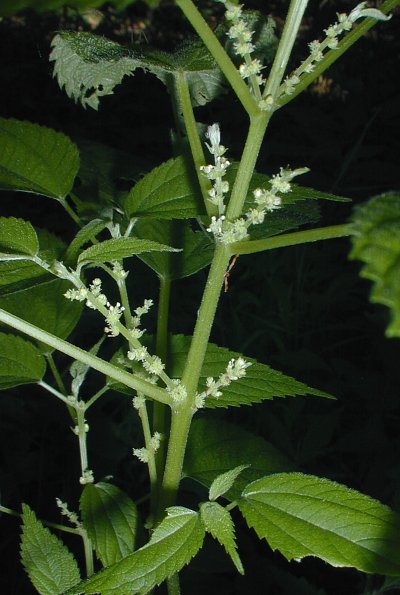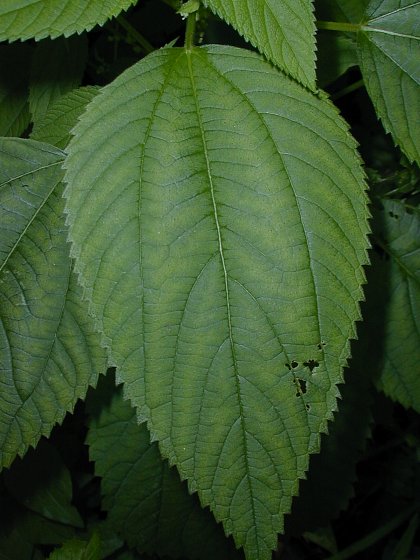Description: This perennial plant is about 2-3' tall, branching occasionally. This member of the Nettle family lacks stinging hairs. The stems are light green, 4-angled or round, and glabrous or slightly pubescent. The leaves are usually opposite along the stems, but sometimes they are alternate. They are ovate or ovate-lanceolate, up to 4" long and 2½" across, and have long slender petioles. The upper surface of each leaf is dark green (in the shade) and glabrous or slightly pubescent; a central vein and 2 parallel secondary veins are readily observable. The margins are coarsely serrated. Spikes of green or greenish white flowers appear from the axils of the upper leaves. They are straight and angle upward from the axis of the central stem. The flowering spikes are about ½–3" long; sometimes they are terminal, but more often they will develop additional leaves beyond the flowers. False Nettle is usually dioecious, with male and female flowers produced on separate plants. Male flowers are distributed along the spikes in bunches, while female flowers are produced along the spikes more or less continuously. These flowers are very small and lack petals. Each male flower has a 4-parted calyx and 4 stamens, while the calyx of the female flower is tubular with 2-4 teeth. The blooming period is mid-summer to early fall, and lasts about 1-2 months. There is no floral scent; pollination is by wind. The fruit consists of a small achene. This description applies to the typical woodland variety of False Nettle, Boehmeria cylindrica cylindrica. The other variety of False Nettle, Boehmeria cylindrica drummondiana, grows in the sun and has a somewhat different appearance.

Cultivation: The
preference is light shade, moist conditions, and rich loamy soil. In
sunnier locations, this plant prefers wetter ground and the foliage may
become yellowish green.
Range & Habitat:
The native False Nettle is a common plant that occurs in most counties
of Illinois
(see Distribution
Map). Habitats include wet to mesic deciduous woodlands,
especially in floodplain and bottomland areas, as well as various
wetlands, including swamps, low areas along rivers, borders of
small streams, seeps, and sandy marshes. False Nettle can be
found in both degraded and higher quality habitats.
Faunal Associations:
The flowers don't attact many insects because they are wind-pollinated.
Caterpillars of the butterflies
Polygonia comma (Comma), Polygonia
interrogationis (Question Mark), and Vanessa
atalanta (Red Admiral) feed on the foliage of False Nettle;
caterpillars of the moth Bomolocha
manalis (Flowing-Line Bomolocha) also feed on this plant
(Wagner, 2005; Bouseman & Sternburg, 2001). Larvae of
a fly, Neolasioptera
boehmeriae,
form spindle-shaped galls on the stems. Because the foliage lacks
stinging hairs and it is non-toxic, mammalian herbivores probably
browse on this plant occasionally.

Photographic
Location:
Along a woodland path at Busey Woods in Urbana, Illinois.
Comments:
Sometimes people instinctively shy away from this plant thinking that
it has stinging hairs – in fact, this is not the case, hence the common
name. In Illinois, the two members of the Nettle family with stinging
hairs are Laportea canadensis (Wood Nettle) and Urtica
dioica (Stinging Nettle). The latter species has been
introduced from Europe. The other common member of the Nettle family
without stinging hairs, Pilea pumila (Clearweed),
is a hairless annual plant with translucent stems and shiny leaves.
Clearweed has terminal flowering spikes that are usually shorter than
the petioles of the leaves, while the flowering spikes of False Nettle
are usually longer than the petioles, and leaves are often produced
beyond
the flowers.